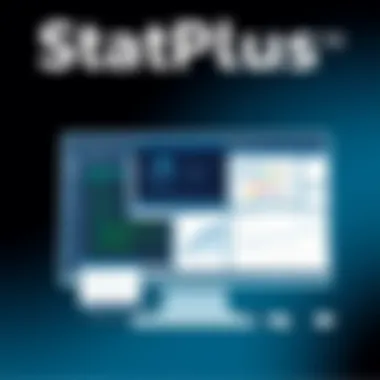An In-Depth Look at StatPlus for Statistical Analysis


Intro
In the world of data analysis, having the right tools at your fingertips can make all the difference. With mountains of data to sift through, both seasoned professionals and newcomers alike must rely on software that aids accuracy and efficiency. StatPlus emerges in this landscape as a powerful statistical tool engineered for a diverse range of users—whether you're deep in academic research or steering a business towards informed decision-making.
This article will take a closer look at StatPlus, from its core functionalities to what sets it apart from competitors. You will discover how this tool not only enhances your statistical prowess but also integrates seamlessly into your daily workflows. Let’s embark on this not-so-ordinary journey, where we peel back the layers of this software to unveil its utility and charm.
Preface to StatPlus
Before diving into the intricacies of statistical analysis software, it's essential to understand what StatPlus is and why it matters. In a world where data shapes decisions across industries, having the right tools can make all the difference. StatPlus is a powerful statistical analysis tool designed to cater to a range of users from academic researchers to business analysts. Its versatility gets to the heart of its appeal; whether you're grappling with complex datasets or looking for straightforward statistical insights, StatPlus offers a helping hand.
What is StatPlus?
StatPlus is a comprehensive software application for statistical analysis that helps users make sense of their data. It predominantly runs on Windows and supports a range of statistical tasks. This tool boasts an array of features, including data analysis, graphical representation, and integration capabilities with other software like Microsoft Excel. Its user-friendly interface allows for a seamless experience, whether you are a seasoned statistician or a newcomer trying to navigate the world of data.
A defining characteristic of StatPlus is its value in analyzing real-world data. Users can conduct complex calculations without needing extensive mathematical know-how, as the software simplifies many statistical concepts. If you're seeking to improve your data prowess, StatPlus is a solution worth considering.
History and Evolution
The journey of StatPlus began several years ago, evolving from simple spreadsheet utilities into a robust statistical powerhouse. Initially, it served basic statistics needs but has pivoted to meet the growing demands of analytical tasks faced by researchers and professionals today. The shift in focus is partly due to the surge in data availability and the necessity for advanced analysis in various fields.
Originally developed for Windows platforms only, StatPlus has adapted over time, incorporating features that allow users to import and analyze data from numerous formats, including CSV and Excel files. As technology and methodologies have progressed, StatPlus has kept pace, implementing updates that align with modern statistical practices.
Today, StatPlus includes various user-friendly tools that make it a go-to choice for a diverse user base. The integration capacities with other software broaden its utility, allowing it to thrive in environments where collaboration and multi-software workflows are commonplace.
Overall, the significance of StatPlus in the realm of data analysis cannot be overstated. Its adaptability and extensive feature set provide users with the tools necessary to turn raw data into actionable insights.
Core Features of StatPlus
When it comes to statistical analysis software, the features it offers can either make or break the user experience. StatPlus has carved out a niche for itself, primarily due to its array of robust core features. This section dives into the integral components that make StatPlus a reliable choice for various users, whether in academia, healthcare, or business analytics. Not only do these features enhance usability, but they also ensure comprehensive data analysis, paving the way for informed decision-making.
Data Analysis Capabilities
StatPlus excels in providing thorough data analysis capabilities, which are essential for anyone working with statistics. Within this domain, three major aspects stand out: descriptive statistics, inferential statistics, and regression analysis.
Descriptive Statistics
Descriptive statistics lays the groundwork for understanding datasets; it's about summarizing and presenting data in a meaningful way. One of the crucial benefits of using descriptive statistics in StatPlus is its ability to provide a clear snapshot of the data at hand. Users can generate measures such as mean, median, or standard deviation all in a matter of clicks. This simplicity is a significant characteristic, making it a popular option among novice and experienced users alike. Moreover, while many tools can give basic summaries, StatPlus takes it a step further by categorizing and detailing data, enabling users to glean insights without drowning in unnecessary complication.
One unique feature of this module is its ability to create frequency distributions and histograms efficiently. However, while the overview provided is insightful, it’s worth noting that descriptive statistics doesn't infer beyond the data—it stops at summarization. In other words, while it can tell you what is happening, it can't tell you why—all the while being a stepping stone for deeper analysis.
Inferential Statistics
Turning to inferential statistics, this aspect is about making predictions or generalizations about a population based on sample data. It’s a more complex realm, but one that StatPlus navigates with relative ease. Users often gravitate towards this feature for its ability to provide confidence intervals, hypothesis tests, and various statistical tests. What makes inferential statistics beneficial within StatPlus is its user-friendly interface that doesn't skimp on sophistication. Even users who might not have an extensive background in statistics can make sense of the results.
The standout ability here is the robust hypothesis testing options, which can quickly determine the validity of a claim based on sample data. On the downside, complexities increase, and the user must have a reasonable grasp of statistics to avoid misinterpretation of the results, so it may require a bit of a learning curve for some.
Regression Analysis
Lastly, regression analysis is perhaps one of the most powerful tools at a researcher’s disposal when examining relationships between variables. In StatPlus, regression analysis shines through its versatility. The ability to run multiple types of regression—from linear to logistic—is highly valued. It empowers users to explore deeper relationships and predict outcomes with a degree of accuracy, lending itself well to various fields such as economics and healthcare.
What stands out as a key characteristic of regression analysis in StatPlus is its dynamic regression modeling capabilities, which allows users to visually dissect their models through residual analysis and goodness-of-fit metrics. This visual aspect aids in comprehending complex relationships. However, while powerful, navigating regression can get cumbersome if users aren’t adept with the underlying assumptions.
Graphical Representation of Data
The ability to graphically represent data can elevate your analysis from mere numbers to compelling visual stories. StatPlus caters well to this need through its comprehensive options for creating charts and graphs as well as customizable visuals.


Charts and Graphs
Utilizing charts and graphs to illustrate statistical findings serves as an intuitive way to communicate results. In StatPlus, the selection of charts available is broad—from bar and line charts to pie charts and scatter plots. Each type serves different purposes, making them beneficial for various audiences. This flexibility aids in delivering presentations that are not only data-driven but also visually engaging.
One unique aspect is how seamlessly users can implement these charts into reports or presentations directly. Having visually appealing representations can significantly impact the readability and interpretation of data. However, one must tread carefully; sometimes, simplifying complex data into charts can lead to misinterpretations if not done transparently.
Customizable Visuals
Moving on to customizable visuals, StatPlus offers users the ability to tailor their graphs extensively. This feature becomes particularly beneficial when trying to emphasize specific data points or trends that are central to the analysis being presented. Options to change colors, labels, and layouts enable personalization, making data more relatable and engaging.
Yet, while customization promotes clarity, it also opens a can of worms if users focus too heavily on aesthetics at the expense of data accuracy. It's a delicate balancing act.
Integration with Other Software
In a world where data often comes from multiple sources, the ability to integrate with other software can be a game changer. StatPlus provides robust integration options that enhance its usability.
Linking with Excel
One of the standout features for many is the ability of StatPlus to link directly with Excel. This facilitation allows users to harness their existing data without the hassle of formatting or manual entry. For analysts accustomed to Excel, this integration feels like a breath of fresh air.
It also means users can move back and forth between the two platforms with ease, ensuring that data remains synced. However, while integration simplifies workflow, there still can be quirks in data handling that users should keep an eye out for, particularly in large datasets.
Importing Data from Various Formats
Finally, StatPlus allows users to import data from various formats. Whether it’s CSV, TXT, or even databases, this flexibility places StatPlus ahead of the curve when compared to competitors that may require a more rigid input format. This characteristic is crucial, particularly for users working with diverse data inputs.
However, one must be wary of potential compatibility issues that can arise, especially with less common formats. It’s an uphill task and may require some troubleshooting, but once it’s set up, it truly broadens the possibilities.
Ultimately, the core features of StatPlus encapsulate its potential as a powerful tool for those engaged in statistical analysis. Each element—data analysis capabilities, graphical output, and integration—contributes significantly to creating a seamless experience for any user aiming to decode data's stories.
User Interface and Experience
The user interface and experience in StatPlus are fundamental to its usability and effectiveness. A well-designed interface ensures that users—whether seasoned statisticians or beginners—can readily navigate the software without feeling lost in a maze of functions. The importance of a smooth user experience can't be overstated; it directly influences how efficiently one can execute statistical analyses. When the design is intuitive, users can focus on their data rather than struggling with the software itself. This section dives deep into the elements of user interface and experience, highlighting features that enhance usability and accessibility.
Navigating the Software
Navigating through StatPlus is akin to embarking on a journey; a clear map can make all the difference. Upon launching the software, users are met with a clean layout, where essential features are conveniently grouped together. Whether it's running a regression analysis or generating descriptive statistics, key functionalities are largely accessible with a couple of clicks.
Here are some points on navigating the software:
- Top Navigation Bar: Features quick access to major functions like data import, analysis options, and output views.
- Contextual Menus: Right-clicking within different sections reveals contextual options, allowing users to make swift choices without sifting through layers of menus.
- Help Features: Tips pop up to guide users as they navigate, ensuring they don't miss critical steps in their analysis.
In sum, navigating StatPlus feels logically structured—users can flow seamlessly from one task to the next, which is a boon for maintaining focus on their analyses.
User Support and Documentation
User support is a lifeline when working with complex software. StatPlus rises to the occasion with a comprehensive support system, including online tutorials and active user forums. These resources play an integral role in illuminating the software’s capabilities, making it easier for users to get answers they need.
Online Tutorials
Online tutorials offered by StatPlus can be seen as the golden ticket to mastering the software. They serve as structured learning paths, guiding users step-by-step through various functions.
- Key Characteristics: The tutorials cover a range of topics, from basic data importing to advanced statistical functions.
- Unique Advantage: An especially beneficial feature is the integration of video tutorials, creating a more dynamic learning experience compared to static text.
- Considerations: While useful, the downside may be that some users prefer hands-on practice over video-based learning. However, the breadth of topics covered compensates for this, catering to various learning preferences.
User Forums


User forums act as bustling communities where StatPlus users exchange insights, troubleshoot issues, and provide feedback to one another. They serve as both a support structure and a knowledge base on the nuances of using StatPlus effectively.
- Key Characteristic: Forums facilitate real-time discussions, enabling quicker resolutions to queries compared to traditional support channels.
- Unique Edge: Users often share templates, scripts, and custom functions, which can enhance analytical capabilities for all members of the community.
- Limitations: One challenge is the varying depth of expertise among users, resulting in some threads containing more noise than useful information. However, active engagement from experienced users helps mitigate this.
Essential takeaway: With the combination of online tutorials and user forums, StatPlus ensures its users have ample resources at their disposal to elevate their statistical analysis skills. The support offered fosters a collaborative environment, further enriching the user experience.
Comparative Analysis with Other Statistical Tools
To comprehend the true power of StatPlus, it’s essential to engage in a comparative analysis with other well-known statistical tools. This approach not only highlights the unique features of StatPlus but also provides insights into where it stands in a crowded field. By dissecting its capabilities alongside competitors, users can make informed decisions tailored to their specific analytical needs.
StatPlus vs. SPSS
The choice between StatPlus and SPSS often comes down to context and user preference. SPSS, developed by IBM, has been a longstanding giant in the field of statistical analysis and is widely embraced in the social sciences. It offers a plethora of features that cater to detailed statistical modeling, ease of use, and robust output options. However, it tends to come with a heftier price tag and can be resource-intensive, particularly on older hardware.
In contrast, StatPlus serves a different slice of the market. While it may not boast the same global recognition as SPSS, StatPlus offers a user-friendly interface that doesn’t compromise on functionality. The software incorporates essential statistical analysis features without overwhelming the user, making it accessible for non-technical experts as well as experienced analysts. Furthermore, StatPlus requires less computational power, making it suitable for smaller setups or less powerful machines.
- Cost-Effectiveness: StatPlus is often more cost-effective, particularly for small businesses or independent researchers who might find the pricing of SPSS prohibitive.
- Usability: Users frequently report that StatPlus's layout provides more intuitive navigation, especially for those who are not familiar with complex statistical methods.
Nonetheless, users requiring advanced statistical processes stemming from SPSS's robust feature set might find StatPlus slightly lacking, which is an important consideration for serious academic research.
StatPlus vs. R
R, on the other hand, is a programming language tailored for statistical computing and graphics. It offers incredible flexibility and the ability to handle massive data sets efficiently. The open-source nature of R has led to a vibrant community, producing a variety of packages that extend its already broad functionality. However, the steep learning curve can be daunting for newcomers, deterring those who prefer straightforward user interfaces.
StatPlus and R serve distinct types of users. StatPlus offers a graphical point-and-click interface that simplifies data manipulation processes. It's particularly advantageous for users who may not possess programming skills but still need to conduct thorough statistical analyses.
- Learning Curve: For many beginners, StatPlus shines with its ease of use compared to R. Learning R can be akin to climbing a mountain when simple data analysis is needed.
- Data Visualization: While R excels in graphing capabilities through packages like ggplot2, StatPlus provides relatable visual options that can be quickly adapted without delving into coding specifics.
In summary, while R is invaluable for advanced statistical analysis and manipulation, StatPlus caters to those who appreciate practicality without the prerequisite of coding experience. Each tool bears strengths and weaknesses; the choice ultimately hinges on the user’s familiarity, comfort level, and specific project requirements.
Choosing the right statistical software can shape the success of your analysis. Evaluate your needs and resources before making a decision.
By examining tools like SPSS and R alongside StatPlus, users gain a clearer picture of what each can provide, facilitating a more informed choice that aligns with their analytical goals.
Practical Applications of StatPlus
The practical applications of StatPlus are vast, stretching across various fields that rely on data-driven decisions. Understanding how this software impacts academic, business, and healthcare sectors is essential not just for users, but for anyone interested in the efficacy of statistical tools. StatPlus is more than just a stat program; it’s a pivotal ally in interpreting data, making sense of complex datasets, and ultimately driving outcomes. The advantages of utilizing such a tool are numerous, particularly in how it can illuminate trends, support hypothesis testing, and facilitate informed decision-making.
In Academic Research
In the realm of academic research, StatPlus serves as a cornerstone for scholars who face the daunting task of data analysis. Researchers often deal with multifaceted datasets, requiring precise statistical evaluation. StatPlus simplifies this process, providing tools that allow for detailed statistical reviews, including t-tests, ANOVAs, and non-parametric tests. Anyone familiar with academic rigor knows that valid results feed into credible research. Thus, StatPlus offers not only the means to analyze but also the credibility that comes with its statistical robustness.
Moreover, the documentation and online resources available for StatPlus help researchers avoid common pitfalls associated with statistical analysis. Users can easily learn how to employ advanced techniques without getting bogged down by overly complex interfaces. Also, the software's ability to handle large data sets seamlessly is a massive benefit—nothing crumbles a research project faster than a tool that can't keep pace with your research ambitions.
In Business Analytics
For businesses—whether small start-ups or large corporations—data analysis is crucial in steering strategic decisions. StatPlus equips business analysts with the capability to draw actionable insights from data trends. From forecasting sales figures to evaluating customer satisfaction, the importance of sound statistical analysis cannot be overstated in today’s competitive landscape. Business professionals leverage StatPlus for its easy integration with Excel, streamlining the process of bringing data from spreadsheets into a software tool that can generate clear reports and visualizations.
StatPlus can facilitate predictive modeling, which is invaluable for strategic planning. Business analysts frequently need to assess the impact of potential market changes and customer behavior; StatPlus’ predictive capabilities shine in these instances, providing businesses with a tangible edge. It allows companies to be proactive rather than reactive, trimming costs through better forecasts and optimized marketing strategies.
In Healthcare Analytics
In healthcare analytics, the stakes are especially high, and accurate data interpretation is crucial for patient care and operational efficiency. StatPlus is often employed by healthcare analysts to assess clinical trial data, conduct epidemiological studies, and monitor patient outcomes. It's not merely about crunching numbers; it’s about enhancing the quality of healthcare services. By leveraging StatPlus to analyze treatment efficacy or patient demographics, healthcare professionals can fine-tune approaches for improved health outcomes.
The role of statistics in healthcare is fundamentally about improving lives. As such, StatPlus aids in compliance with rigorous standards and regulations that govern healthcare practices. Researchers in health-related fields utilize its comprehensive statistical package to fulfill requirements for peer-reviewed articles, grants, and regulatory submissions. Moreover, with healthcare increasingly relying on data to drive policy decisions, having a robust tool like StatPlus at one's disposal is simply indispensable.


"In data we trust, especially when powered by tools that can make sense of complexity."
Through these diverse applications across academic research, business analytics, and healthcare, StatPlus manifests its capability as a multifaceted statistical tool, catering specifically to the varied needs of its users. The critical insights drawn from data with StatPlus not only drive compelling narratives but can also lead to innovations and enhancements in their respective fields. As such, understanding the practical applications of StatPlus truly reflects its transformative potential.
Strengths and Weaknesses of StatPlus
Understanding the strengths and weaknesses of StatPlus not only sheds light on its capabilities but also aids users in making an informed decision regarding its implementation in their analytical toolkit. This section delves into the key benefits and limitations of StatPlus, examining aspects that can be crucial for professionals across various domains.
Advantages of Using StatPlus
StatPlus is known for several noteworthy advantages that cater to a diverse audience, from academic researchers to business analysts. Here are the primary benefits:
- User-Friendly Interface: One of the standout features is its clean and intuitive design. Even those who may not be tech-savvy find StatPlus approachable. The layout is logical, reducing the steep learning curve often associated with statistical software.
- Robust Analytical Tools: StatPlus is equipped with an impressive array of statistical methods—ranging from basic descriptive statistics to complex inferential analyses. This wide spectrum allows users to perform a thorough examination of their data, regardless of its nature.
- Integration Capabilities: The ability to seamlessly link with Microsoft Excel is a significant plus. This integration allows users to directly import datasets, perform analysis, and export results without undue complications.
- Comprehensive Support Resources: Users gain access to a plethora of support materials, including online forums and tutorials. This community backing can be invaluable for troubleshooting and enhancing one's knowledge about the software.
- Flexible Visualization Options: StatPlus offers a variety of graphing tools, enabling users to represent data visually in several formats. The ability to customize visuals means analysts can tailor presentations to specific audiences effectively.
Overall, the advantages present a compelling case for choosing StatPlus as a go-to statistical analysis tool, leveraging its usability and robust capabilities.
Limitations and Areas for Improvement
Despite its myriad strengths, StatPlus is not without its flaws. Understanding these limitations can help potential users weigh whether it meets their specific needs:
- Cost: While the investment in StatPlus may prove worthwhile for serious users, the pricing can deter casual analysts or those working with tight budgets, especially when there are free alternatives available.
- Limited Advanced Features: Some advanced statistical techniques may be underrepresented compared to other heavyweight competitors, like R or SPSS. Users requiring very specialised analyses might find their needs unmet.
- Performance Issues with Large Datasets: Users have reported slower processing times when handling hefty databases. For analysts working with extensive data, this can lead to frustration and inefficiency.
- Need for Further Documentation: For some features, in-depth documentation may be scarce. New users might find it challenging to fully exploit the software's capabilities without substantial digging through online forums or external resources.
- Compatibility Issues with Various File Formats: While it supports many formats, occasional hiccups occur when importing files from certain databases or software. This limitation can disrupt workflows and affect data integrity.
In summary, while StatPlus shines in several areas, users must consider these weaknesses relative to their requirements. Being aware of both sides can make the difference in achieving robust statistical insights or facing hurdles that could affect their productivity.
User Feedback and Community Insights
User feedback is a cornerstone for shaping any software tool, and StatPlus is no exception. This aspect is crucial because it not only reflects the needs and expectations of users but also drives improvements and innovations within the software. By actively listening to its user community, the developers of StatPlus can refine its features, enhance user experience, and address any shortcomings that may arise. Furthermore, community insights foster a sense of belonging among users, allowing them to share tips, solve problems together, and ultimately enhance their proficiency with the software.
In the world of statistics, where accuracy and reliability are paramount, understanding what real-world users think about a tool can provide invaluable insights for prospective customers. Whether one is a seasoned statistician or a mere novice, community feedback can illuminate the path toward maximizing the effectiveness of StatPlus. Here’s a closer look at positive experiences reported by users, alongside the common challenges encountered.
Positive User Experiences
Many users have touted StatPlus as a versatile tool that caters to an array of applications. Whether in academia or business, the software's robust features have garnered enthusiastic responses. Users often highlight the ease of navigating through the software, even for those without extensive statistical backgrounds. For example, a marketing analyst noted how the straightforward interface allowed them to generate insightful reports without needing a dedicated statistician on hand. Their ability to create custom charts and graphs efficiently was a game changer.
Additionally, the integration capabilities of StatPlus with popular software like Microsoft Excel serve as a significant advantage. Users appreciate how seamlessly they can transfer data between these platforms, streamlining workflows that were once riddled with inefficiencies. The availability of online tutorials has also been a boon, as users can quickly solve minor hiccups and get back to their projects without missing a beat.
"StatPlus has empowered me to analyze data at a level I never imagined. The user community has helped me find solutions to problems I didn’t even know I had." – StatPlus User
Common Challenges Faced by Users
Not all experiences with StatPlus have been rosy, and some users continue to face challenges that can hinder their productivity. One common complaint centers around the learning curve associated with some of the tool's advanced statistical analyses. Particularly for those without a robust background in statistics, some users find the documentation lacking in crucial details, which can lead to confusion. This has prompted a discussion in user forums about the need for more comprehensive guides or tutorials.
Furthermore, while the integration with Excel is generally appreciated, some users report occasional syncing issues that can complicate data analysis tasks. Careful attention is required to ensure compatibility, which can take time to master.
Lastly, while StatPlus is capable, its pricing structure has been a talking point. Some users feel that certain functionalities crucial for businesses can be expensive when added to the base package. More transparency in pricing could alleviate concerns and foster confidence in potential users.
End
The importance of drawing conclusions in the realm of statistical analysis cannot be overstated. Every study, report, or project that utilizes data hinges on the insights that come from the interplay of evidence and inference. In this article, the concluding segment encapsulates key insights gained from our exploration of StatPlus and emphasizes its significance as a statistical tool.
Summary of Key Points
Throughout the article, several pivotal themes emerged about StatPlus. First, we highlighted the diverse data analysis capabilities of StatPlus, which cater to various statistical needs, from descriptive to inferential methods. Second, the software’s integration with other popular platforms like Excel improves user experience, facilitating seamless data manipulation.
Furthermore, we delved into the user interface, noting how its structured layout enhances navigability, making it approachable even for users unfamiliar with statistical software. Feedback from the community sheds light on both the strengths and weaknesses of the tool, revealing that while many users value its robust features, there are common challenges that can hinder the user experience. Ultimately, StatPlus proves to be an effective platform for those engaging in academic research, business analytics, or healthcare analytics.
Final Recommendations
When considering the adoption of StatPlus, potential users should weigh its benefits against their specific needs. Here are several final recommendations:
- Assess Specific Needs: Before committing to StatPlus, evaluate your unique statistical needs. Whether you’re in academia or the corporate world, understanding how StatPlus aligns with your requirements is critical.
- Utilize Community Resources: Engage with available online forums and user tutorials. The collective knowledge of the community can be a game-changer when facing hurdles.
- Take Advantage of Free Trials: If possible, explore trial versions. Familiarizing yourself with the software firsthand can provide clarity on its functionality and fit for your project.
- Stay Updated: As software landscapes constantly evolve, keeping an eye on updates and improvements to StatPlus will ensure you’re leveraging its full potential over time.
In summary, the conclusion serves as a reminder of StatPlus's capability to empower its users through a comprehensive suite of features tailored for various analytical tasks. By following the insights and recommendations provided, users can enhance their statistical analysis skills and effectively navigate the often complex world of data.







